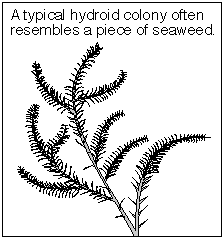Published in the Ocean Watch column, Honolulu Star-Advertiser © Susan Scott
June 3, 1996
DURING a recent dive, my partner motioned for me to look at something he found. I squinted into the dark crack where he was pointing. What is that moving around back there? I wondered. Shrimp? I leaned closer. Yes. Here was a group of odd but charming shrimp, a species I hadn’t seen before.
I leaned into the cave to get a better look, but my giant, bubbling face alarmed the little creatures. They moved toward the back of their shelter.
Determined to see them better, I adjusted my grip to push myself forward. Then . . . Ouch! A sharp pain on the underside of my right wrist made me jerk my arm up. I looked down. My hand had been resting near what looked like a lovely bouquet of white feathers. But the angelic appearance of these plumes didn’t trick me. I knew I had just received my first hydroid sting.
Hydroids look like delicate seaweeds, but they are actually animals, closely related to corals, jellyfish, sea anemones and Portuguese man-of-war.
At least 28 species of hydroids, most standing only a few inches tall, inhabit the shallow waters of the main Hawaiian Islands. They are also common along coastlines nearly everywhere else in the world. Rocks, boat bottoms, and piers often bear colonies of these delicate creatures.
The dainty appearance of these animals is deceiving. Hydroids are carnivores, using their nematocyst-laden feeding tentacles, positioned along their “branches”, to sting  and catch passing shrimp, worms and animal plankton.
and catch passing shrimp, worms and animal plankton.
These stinging nematocysts also discharge venom into human skin upon contact. Hydroid stings are fairly common among people who clean fouled boat bottoms. Also, scuba divers sometimes get hydroid stings by accidentally brushing up against a colony, like I did during the shrimp incident.
Hydroids can cause other trouble. In 1955, pieces of hydroid colonies were dislodged from rocks during construction of a pier in Hilo Harbor. Project workers, who often were standing in the water, were plagued by these drifting remnants that got caught under their clothing.
Most hydroid stings almost immediately produce small red bumps that remain itchy and painful for hours. Sometime victims feel a prickly sensation. This rash can last up to 10 days. Skin with hair on it usually has less reaction than bare skin. More-severe sting reactions are blisters, swelling and hives.
No cure exists. Rinse the sting with water, (salt or fresh), to wash away any adhering nematocysts, then apply ice for pain. For persistent itching or skin rash, try 1 percent hydrocortisone ointment four times a day, and one or two 25 milligram diphenhydramine (Benadryl) tablets every six hours. Diphenhydramine may cause drowsiness so don’t drive, swim or surf after taking this medication. Both these drugs are sold without prescription.
If the rash worsens, allergic symptoms occur, or a feeling of generalized illness develops, see a doctor immediately.
I didn’t do anything to my hydroid sting except take a shower after the dive. My wrist burned for an hour or so, then became a minor rash, disappearing in about a week.
The discomfort was worth it. I got a great look at those shrimp.